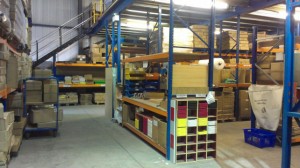Safety in the Warehouse
 Thousands of serious injuries happen in warehouse environments each year according to the Health and Safety Executive (HSE). Most of these injuries occur through improper handling of goods and machinery, slips, trips and falls, and accidents involving other vehicles. Other injuries happen because of poorly maintained racking systems. Here are a few safety tips and checks that should be carried out when working in a warehouse or storage environment.
Thousands of serious injuries happen in warehouse environments each year according to the Health and Safety Executive (HSE). Most of these injuries occur through improper handling of goods and machinery, slips, trips and falls, and accidents involving other vehicles. Other injuries happen because of poorly maintained racking systems. Here are a few safety tips and checks that should be carried out when working in a warehouse or storage environment.
Vehicles and Heavy-Duty Equipment
Vehicles and heavy-duty equipment such as pallet trucks, forklifts, stackers and other warehouse trucks, account for the majority of injuries in a warehouse.
Knowing what precautions you need to take is vital for keeping workers safe. But also, some accidents happen to the users of the equipment because they do not know which truck to use for which job and what the trucks capacity is. Using the wrong truck and capacity when dealing with goods, could end in a nasty accident, e.g. forklifts overturning, injury to the user.
Traffic Routes
Use clearly marked and well planned traffic routes both indoors and outdoors and ideally pedestrian and vehicle access should be adequate separated in warehouses if possible. When planning a route, always consider vehicle and pedestrian separation first – if it is not possible, use other control measures.
Devise one way traffic systems, and avoid creating sharp bends, blind spots and that the route surface is even and maintained properly.
If in close proximity with people, vehicles should be fitted with warning lights and audible alarms.
Pedestrian Safety
When employees are walking around the warehouse, they should be wearing High Visibility Clothing so they can be clearly seen in and around the warehouse.
Restrict access to dangerous areas from workers who are not operating vehicles.
Vehicle Maintenance
Ensure that all drivers are trained and authorised.
Assess vehicles regularly and ensure they are safe to use.
Label all trucks with their uses and capacities so they are used correctly.
Storage and Racking
Stacking and retrieval of goods is a dangerous activity if not handled in the correct way. Unsafe methods could lead to accidents e.g. workers climbing on the racking, forklifts attempting to remove and store goods or using unsuitable equipment.
Overloading shelves or racking may lead to them collapsing and stacking goods incorrectly, could lead to them being unsecured and falling off the racking.
Stacking Goods
Don't exceed the weight limit of the racking you are using. When loading any goods onto racking, ensure that the racking is capable of supporting the load.
Train staff on safe methods of how to remove and stack goods.
Stack goods securely, load the heaviest on the bottom pallet.
Organise racking into aisles to allow easy and safe access to goods.
Racking and Pallet Maintenance
Assess the pallets each time before stacking anything on them, make sure they are in a safe condition and any that are damaged, take out and repair or throw away. Keep a record of any inspections, damage or repairs in a logbook for future reference.
-You should use three types of inspection:
-Immediate reporting of damage and defects
-Visual inspections at regular intervals
-'Expert' inspections carried out at intervals by a competent person
Handle empty pallets with care – do not drag or throw them about.
To prevent damage to racking, invest in some racking protection. This will provide protection against vehicles damaging racking if it happens to collide into it. It also prevents the racking from being shook and goods falling off.
Manual Handling
Many workers suffer from aches and pains when dealing with heavy lifting in the warehousing and storage industry. This is because they are not taking the right precautions when manually handling products.
When carrying out a manual handling assessment, you as an employer and as an employee should consider:
-The task
-The load – how heavy is it?
-The working equipment
-Your individual capability – are you able to handle the task that is set?
-And other factors that may occur
Employees should be given information about the task before carrying it out, such information should include, the weight of the load and it's heaviest side – if its centre of gravity is not central.
Use mechanical devices if you are not capable of carrying out the task e.g. trolleys, pallets trucks and sack trucks.
Provide training in safe manual handling. Training can be provided by a company called IOSH. They are the biggest health and safety membership organisation in the world.
Slips and Trips
All slips, trips and falls can be prevented by keeping up with general housekeeping.
Slips
When a spillage occurs, the area should be cornered off and be reported. Then an authorised person will need to clean it up immediately and warning signs should be displayed, but they should not be obstructing anything other than the area of the spillage.
Trips
If any packaging is left on the floor, it could cause a hazard for pedestrians and vehicles. Anyone who drops or leaves packaging in a hazardous place, is responsible for clearing it up. Have disposal bins around the warehouse so packaging can be cleared away properly.
Keep passageways , stairs and racking areas clear at all time.
Fasten cables securely to the floor by using a Cable Protector.
Regular maintenance of surfaces could prevent potholes and uneven ground appear. These could cause accidents to drivers in vehicles and pedestrians.
Posted in Warehouse, Health and Safety